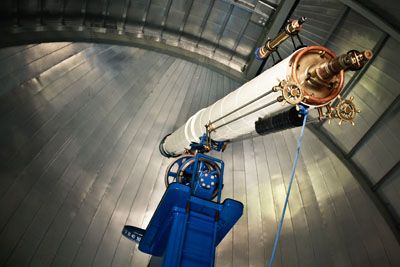
|
While it took decades to do so, dark matter is finally becoming widely accepted and heavily researched within the scientific community.
Now, through a collaborative global effort, researchers have published a study that has figured out the requirement for just how much of this elusive dark matter is needed to form starbursts, galaxies bursting with stars. UC Irvine professor Asantha Cooray is the lead investigator of the study. Along with postdoctoral fellow Alex Amblard and UCI undergraduates Ali Khostovan, Chris Frazer and Ketron Mitchell-Wynne, Cooray and his team researched data from the Herschel Space Observatory. “UCI has a partnership with the Herschel Space Observatory, primarily a European Space Agency mission with important contributions from NASA,” Cooray said. Recently launched in May of 2009 and costing 1.2 billion euros, the Herschel telescope is the largest one in space for astronomy, about the size of a school bus, and is one and a half million kilometers away from Earth. The arrays of super-sensitive detectors that are used to image the universe are cooled by liquid helium to a temperature of 300 milli-Kelvin above absolute zero, making it the coldest instrument launched into space. However, because it needs liquid helium, the resources are finite, projected to run out in 2012. When that happens, it will eventually get thrown out of the solar system. Herschel is different from other telescopes in that it operates in the infrared wavelength, rather than in visible light. Any data collected must be above the Earth’s atmosphere because water interferes with its reading. “This is the first time we have imaged the universe at long, infrared wavelengths,” Cooray said. The Herschel shows a map of the galaxy, uncovering how it is not uniform; rather, it has a pattern, filled with different filaments. Cooray and his team have put in years of effort to produce this groundbreaking study. Cooray has been a part of the Herschel project since 2000, as a member of the U.S. team that built and now operates one of the scientific instruments on Herschel. While it took nine years to launch, it only took one year to analyze Herschel’s data. After looking at the statistics, Cooray and the team concluded that it takes “300 billion masses of dark matter, in terms of the sun, to form starbursts.” The result lets astronomers and cosmologists get one step closer in understanding issues that regard the whole universe, including how stars and planets came to be and when the first galaxies and stars actually formed. Some galaxies form large amounts of stars very quickly, approximately 100 to 1,000 stars that last 10 to 100 million years. To put this in perspective, the Milky Way galaxy forms just one or two stars a year. “We don’t yet fully understand galaxy and star formation. The indirect evidence we have is by studying galaxies today and inferring what history should be like, but we are able to directly see the past happening through Herschel, which is extremely beneficial,” Cooray said. Cooray is also part of a large international collaborative effort to measure the dark matter in individual galaxies with a project called ALMA, which is based in Chile. Composed of 66 telescopes, ALMA operations are estimated to start within the next five years. It is crucial that telescopes are built in dry conditions because water in the atmosphere absorbs infrared wavelengths. Building upon Herschel, ALMA will provide enough resolution to see galaxies individually, allowing scientists to map out the gas in galaxies. “Herschel tells us where to point our telescopes,” Cooray said. “ALMA, which can be used for a very long time, follows up on 100,000 galaxies that stemmed from the Herschel data. It will help us figure out what is going on inside those galaxies.” “There is an underlying wobble in the fabric of the universe,” said postdoctoral research fellow Julie Wardlow. “Gravity tugged on it and pulled it together, which evolved to form galaxies and produced a dip in the distribution. Dark matter surrounds galaxies and clusters of galaxies, which forms a halo.” Cooray is also leading an experiment using short-duration NASA rockets that will tell scientists something about the very first stars, a realization that he considers one of his “proudest achievements.” At one point in time, the universe was completely empty. Gas expanded until about five to six hundred million years after the big bang. Stars formed from helium and hydrogen because those gasses were all that was available in the universe at that time. “The very first stars and galaxies that formed in the universe had different statistical properties than the galaxies now,” said Joseph Smidt, a graduate student in Cooray’s lab. “The rockets are designed to observe the gravity tug on galaxies and stars and measure the clustering properties on various scales in the sky.” They are also paving the way for studying a phenomenon called gravitational lensing, which occurs when galaxies that are extremely far away line up with those that are close to researchers. Otherwise unfeasible to detect because of their faintness, these background galaxies are lighted by the closer galaxies and become incredibly bright in the wavelengths of Herschel. “From that, we can investigate what happened in the early universe that we would never have been able to study,” Wardlow said. To propel the research further, Cooray’s team is also working on modeling just how much the foreground galaxies affect the brightness configuration of the background sources. “We are all part of a large collaborative project, a happy harmony,” said Cooray. “I am really looking forward to what’s next.”
|

